My Wine Cooler Incubator
May 7, 2011
May 7, 2011
I have Hova-bator with egg turner and while it works very well, I would like to have something a bit more durable and would like to be able to incubate multiple trays of eggs simultaneously. The incubators made from Wine Coolers were particularly interesting to me as they look very much like the commercial cabinets that are available.Seeing all the homemade incubators on BYC inspired me to try my hand at creating a homemade incubator.
I put a "Wanted" ad on my local freecycle forum for a non-working wine cooler and had a response within a few hours. It was a very clean unit that the refrigeration system had failed on. I removed the compressor and cooling coils and removed the wiring for the compressor. I left the electricals for the light and thermometer in place so that I could use them in incubator.
Here is a picture of the completed incubator:

Now for a few details on the construction:
I cut four holes with a hole saw in the back of the cooler to allow ventilation. I used short pieces of 1/2" PVC to go through the holes and used a short coupling on the inside and a coupling with threads on the outside. This provides a finished look to the vent holes and the threaded couplings can be sealed using screw-in caps to have complete control over the amount of ventilation.
I also made a pipe stand out of PVC that allows me to fill the water reservoir for humidity control from the outside. It also has a threaded coupling that can be closed with a cap.
I fastened a multi-outlet power strip to the cooler in the area that formerly housed the compressor. I plugged the power for the wine cooler into the power strip so that the light and thermometer are operational. The AC adapter for the 12 Volt computer fan and the Thermostat get their power from the power strip.
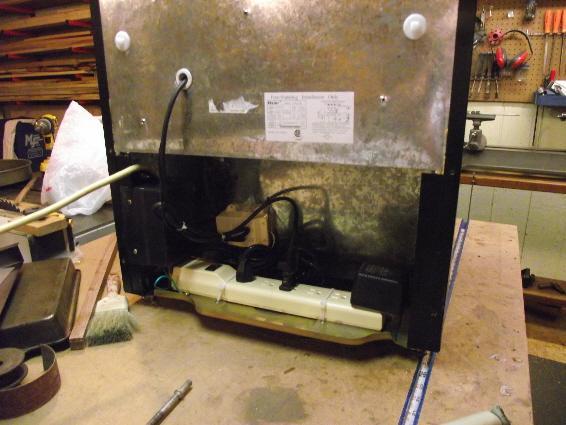

I purchased two construction lamp pigtails to use as heating elements. Two were used in case of a bulb blowing, when I'm not around to notice. I made a bracket to hold the lamps from some sheet metal I had lying around. I used a properly sized hole saw to make two holes in the bracket and inserted the lamps. I used wire ties as clamps on the backside of the bracket to hold the lamps in place. I then pulled a 120 V cord in through the hole left by the removed refrigeration coil and routed it to the lamps.
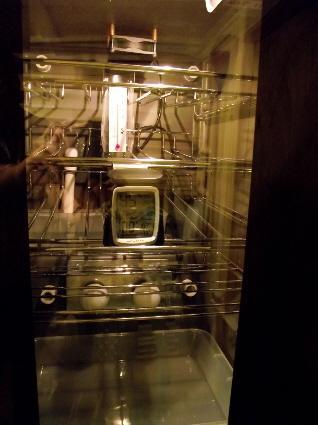
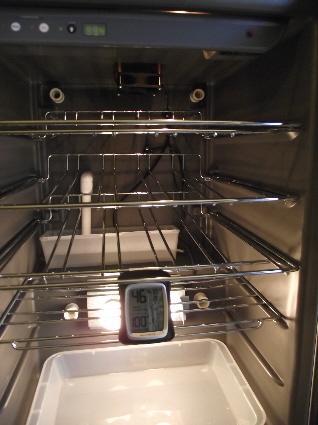
To maintain even heat distribution, I installed a 12 Volt computer fan with spacers in the top of the incubator. It placed it so that it blows air up. It pulls air up the center and pushes it down the sides for even heating. I used a 12 Volt AC to DC adapter to power the fan. (120 Volt AC in 12 Volt DC out).

A plastic container was added to the shelf at the back of the wine-cooler. The PVC pipestand mentioned above feeds into this, so it can be filled with water without opening the door during lockdown.
I kept the existing wire shelving and will be placing egg turners on them. If necessary, I will cover them in plastic mesh so they do not interfere with the operation of the egg turners.
I purchased a ReptiTemp 500R off of Amazon for temperature control. It has a remote temperature sensor that is fed into the incubator via the hole that was previously used for the cooling coils. The thermostat is plugged into the power strip and the heating lamps are plugged into the ReptiTemp. The ReptiTemp has a wheel for adjusting the thermostat's temperature setting. After a bit of trial and error the correct setting is found and can be fine tuned by moving the wheel a small amount.
I placed a plastic pan in the bottom of the incubator for hatching. I will probably not use this feature as I will have multiple trays of eggs incubating. So, I plan to use my Hova-bator for lock down and hatching.
I purchased a thermometer/hygrometer from Walmart to monitor the temp and humidity. I checked it for accuracy using the glass thermometer provided with the Hova-bator. I also checked the accuracy of the hygrometer by placing it in the Hova-bator with one reservoir filled with water which results in 50% humidity. I had to return one unit as it was way off on temp and humidity.
Here are a few more shots of the completed incubator.
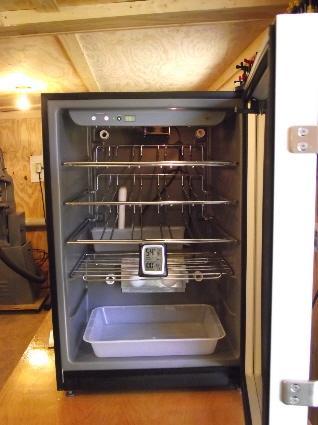

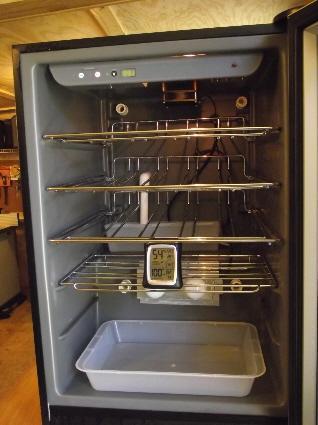
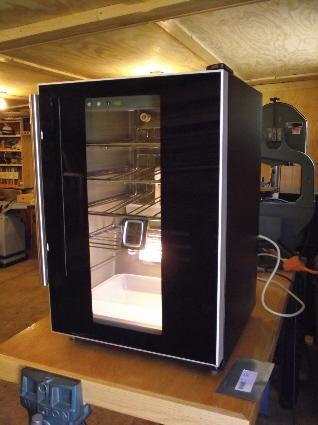
The final cost was very low since the wine cooler was free.
ReptiTemp 500R $27.00 (free shipping on Amazon)
Thermometer/Hygrometer $8.00
PVC Couplings $8.00
Lamp Pigtails $6.00
Total $49.00
I will be adding egg turners at a cost of $40 each. ( I have one and can add two more.)
The incubator was tested for 48 hours and it held temp and humidity. I added 11 eggs tonight, so we'll wait and see how it goes.
